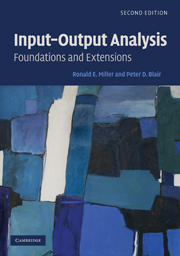Book contents
- Frontmatter
- Contents
- List of Figures
- List of Tables
- Preface
- 1 Introduction and Overview
- 2 Foundations of Input–Output Analysis
- 3 Input–Output Models at the Regional Level
- 4 Organization of Basic Data for Input–Output Models
- 5 The Commodity-by-Industry Approach in Input–Output Models
- 6 Multipliers in the Input–Output Model
- 7 Nonsurvey and Partial-Survey Methods: Fundamentals
- 8 Nonsurvey and Partial-Survey Methods: Extensions
- 9 Energy Input–Output Analysis
- 10 Environmental Input–Output Analysis
- 11 Social Accounting Matrices
- 12 Supply-Side Models, Linkages, and Important Coefficients
- 13 Structural Decomposition, Mixed and Dynamic Models
- 14 Additional Topics
- Appendix A Matrix Algebra for Input–Output Models
- Appendix B Reference Input–Output Tables for the United States (1919–2006)
- Appendix C Historical Notes on the Development of Leontief's Input–Output Analysis
- Author Index
- Subject Index
6 - Multipliers in the Input–Output Model
Published online by Cambridge University Press: 05 June 2012
- Frontmatter
- Contents
- List of Figures
- List of Tables
- Preface
- 1 Introduction and Overview
- 2 Foundations of Input–Output Analysis
- 3 Input–Output Models at the Regional Level
- 4 Organization of Basic Data for Input–Output Models
- 5 The Commodity-by-Industry Approach in Input–Output Models
- 6 Multipliers in the Input–Output Model
- 7 Nonsurvey and Partial-Survey Methods: Fundamentals
- 8 Nonsurvey and Partial-Survey Methods: Extensions
- 9 Energy Input–Output Analysis
- 10 Environmental Input–Output Analysis
- 11 Social Accounting Matrices
- 12 Supply-Side Models, Linkages, and Important Coefficients
- 13 Structural Decomposition, Mixed and Dynamic Models
- 14 Additional Topics
- Appendix A Matrix Algebra for Input–Output Models
- Appendix B Reference Input–Output Tables for the United States (1919–2006)
- Appendix C Historical Notes on the Development of Leontief's Input–Output Analysis
- Author Index
- Subject Index
Summary
Introduction
One of the major uses of the information in an input–output model is to assess the effect on an economy of changes in elements that are exogenous to the model of that economy. For example,
Leontief input–output economics derive their significance largely from the fact that output multipliers measuring the combined effects of the direct and indirect repercussions of a change in final demand were readily calculated.
(Steenge, 1990, p. 377.)In Chapters 2 and 3 we presented several numerical illustrations of the ways in which assumed changes in final-demand elements (e.g., federal government spending, household consumption, exports) were translated, via the appropriate Leontief inverse, to corresponding output changes in the industrial sectors of the economy. When the exogenous changes occur because of the actions of only one “impacting agent” (or a small number of such agents) and when the changes are expected to occur in the short run (e.g., next year), this is usually called impact analysis. Examples are a change in federal government defense spending or in consumer demand for recreation vehicles.
On the other hand, when longer-term and broader changes are examined, then we are dealing with projections and forecasting. If we project the levels of final demand for outputs of all sectors in an economy five years hence, and estimate, using the Leontief inverse, the outputs from all sectors that will be needed to satisfy this demand, this is an exercise in forecasting.
- Type
- Chapter
- Information
- Input-Output AnalysisFoundations and Extensions, pp. 243 - 302Publisher: Cambridge University PressPrint publication year: 2009



